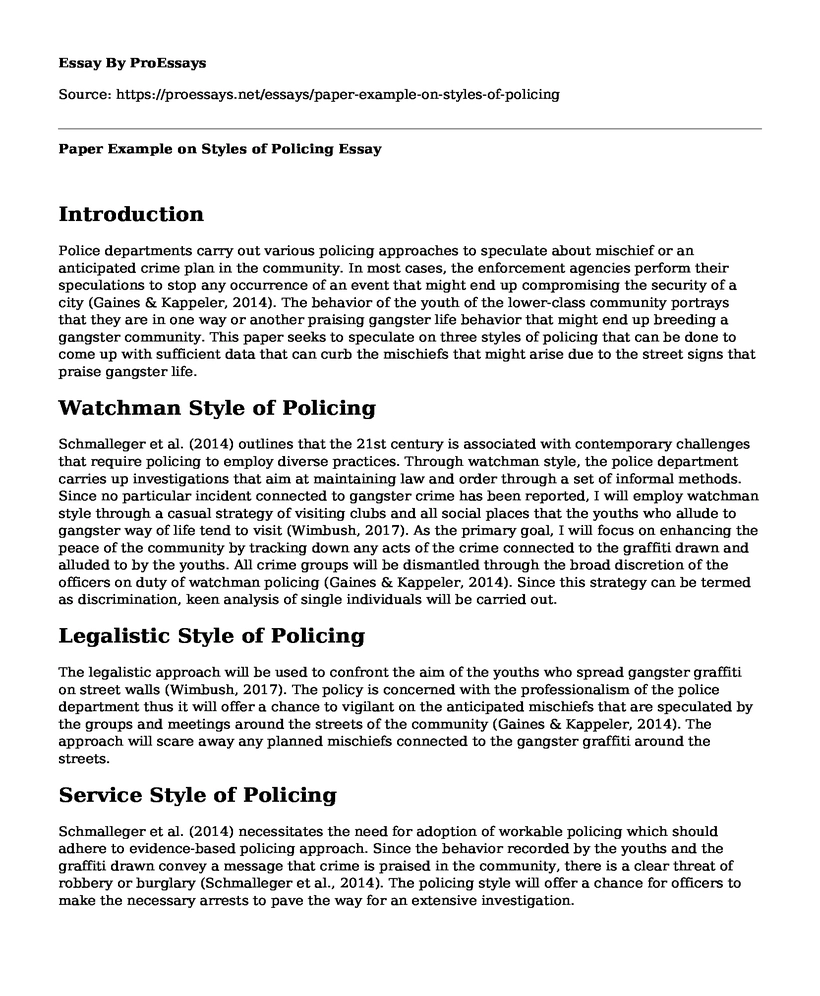Introduction
Police departments carry out various policing approaches to speculate about mischief or an anticipated crime plan in the community. In most cases, the enforcement agencies perform their speculations to stop any occurrence of an event that might end up compromising the security of a city (Gaines & Kappeler, 2014). The behavior of the youth of the lower-class community portrays that they are in one way or another praising gangster life behavior that might end up breeding a gangster community. This paper seeks to speculate on three styles of policing that can be done to come up with sufficient data that can curb the mischiefs that might arise due to the street signs that praise gangster life.
Watchman Style of Policing
Schmalleger et al. (2014) outlines that the 21st century is associated with contemporary challenges that require policing to employ diverse practices. Through watchman style, the police department carries up investigations that aim at maintaining law and order through a set of informal methods. Since no particular incident connected to gangster crime has been reported, I will employ watchman style through a casual strategy of visiting clubs and all social places that the youths who allude to gangster way of life tend to visit (Wimbush, 2017). As the primary goal, I will focus on enhancing the peace of the community by tracking down any acts of the crime connected to the graffiti drawn and alluded to by the youths. All crime groups will be dismantled through the broad discretion of the officers on duty of watchman policing (Gaines & Kappeler, 2014). Since this strategy can be termed as discrimination, keen analysis of single individuals will be carried out.
Legalistic Style of Policing
The legalistic approach will be used to confront the aim of the youths who spread gangster graffiti on street walls (Wimbush, 2017). The policy is concerned with the professionalism of the police department thus it will offer a chance to vigilant on the anticipated mischiefs that are speculated by the groups and meetings around the streets of the community (Gaines & Kappeler, 2014). The approach will scare away any planned mischiefs connected to the gangster graffiti around the streets.
Service Style of Policing
Schmalleger et al. (2014) necessitates the need for adoption of workable policing which should adhere to evidence-based policing approach. Since the behavior recorded by the youths and the graffiti drawn convey a message that crime is praised in the community, there is a clear threat of robbery or burglary (Schmalleger et al., 2014). The policing style will offer a chance for officers to make the necessary arrests to pave the way for an extensive investigation.
References
Gaines, L. K., & Kappeler, V. E. (2014). Policing in America. Routledge.
Schmalleger, F., Donaldson, S., Kashiwahara, K., Koppal, T., Chase, S., Brown, A., ... & Marash, D. (2014). Criminal justice today. Prentice Hall.
Wimbush, P. (2017). What are the seven styles of policing? Criminal Law. Retrieved from https://legalbeagle.com/8213435-7-different-styles-policing.html
Cite this page
Paper Example on Styles of Policing. (2022, Jul 27). Retrieved from https://proessays.net/essays/paper-example-on-styles-of-policing
If you are the original author of this essay and no longer wish to have it published on the ProEssays website, please click below to request its removal:
- Compare and Contrast Essay on Juvenile and Adults Justice Systems
- Effects of Globalization and Neoliberalism on States
- Paper Example on Absolute Monarchy Towards Constitutional Monarchy in Great Britain
- Essay Sample on Rogue Lawyer: Cynical Fight for True Justice
- Final Report: Summary of Criminal Investigation Process - Essay Sample
- Essay Example on Ruth Bader Ginsburg: An Icon of Equality, Liberties and Rights
- Violating Patient's Confidentiality - Essay Sample







